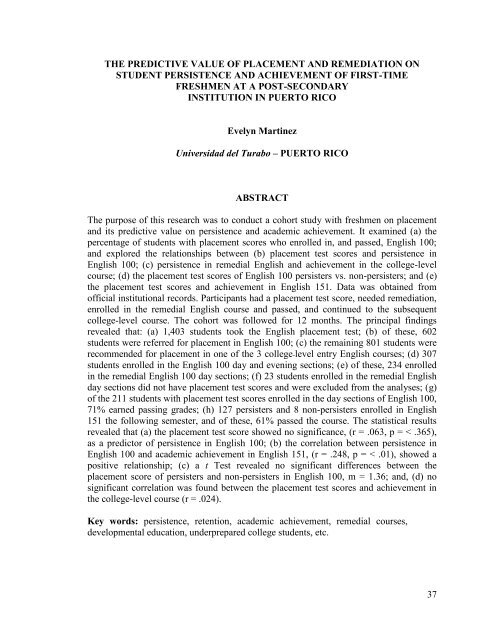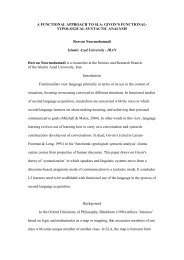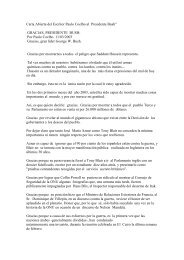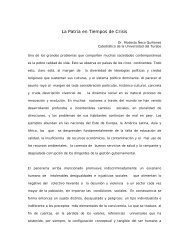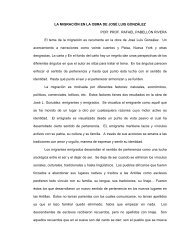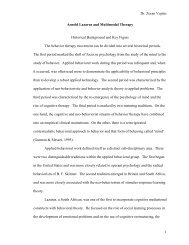UNIVERSIDAD DEL TURABO - Biblioteca virtual de la Universidad ...
UNIVERSIDAD DEL TURABO - Biblioteca virtual de la Universidad ...
UNIVERSIDAD DEL TURABO - Biblioteca virtual de la Universidad ...
You also want an ePaper? Increase the reach of your titles
YUMPU automatically turns print PDFs into web optimized ePapers that Google loves.
THE PREDICTIVE VALUE OF PLACEMENT AND REMEDIATION ON<br />
STUDENT PERSISTENCE AND ACHIEVEMENT OF FIRST-TIME<br />
FRESHMEN AT A POST-SECONDARY<br />
INSTITUTION IN PUERTO RICO<br />
Evelyn Martinez<br />
<strong>Universidad</strong> <strong>de</strong>l Turabo – PUERTO RICO<br />
ABSTRACT<br />
The purpose of this research was to conduct a cohort study with freshmen on p<strong>la</strong>cement<br />
and its predictive value on persistence and aca<strong>de</strong>mic achievement. It examined (a) the<br />
percentage of stu<strong>de</strong>nts with p<strong>la</strong>cement scores who enrolled in, and passed, English 100;<br />
and explored the re<strong>la</strong>tionships between (b) p<strong>la</strong>cement test scores and persistence in<br />
English 100; (c) persistence in remedial English and achievement in the college-level<br />
course; (d) the p<strong>la</strong>cement test scores of English 100 persisters vs. non-persisters; and (e)<br />
the p<strong>la</strong>cement test scores and achievement in English 151. Data was obtained from<br />
official institutional records. Participants had a p<strong>la</strong>cement test score, nee<strong>de</strong>d remediation,<br />
enrolled in the remedial English course and passed, and continued to the subsequent<br />
college-level course. The cohort was followed for 12 months. The principal findings<br />
revealed that: (a) 1,403 stu<strong>de</strong>nts took the English p<strong>la</strong>cement test; (b) of these, 602<br />
stu<strong>de</strong>nts were referred for p<strong>la</strong>cement in English 100; (c) the remaining 801 stu<strong>de</strong>nts were<br />
recommen<strong>de</strong>d for p<strong>la</strong>cement in one of the 3 college-level entry English courses; (d) 307<br />
stu<strong>de</strong>nts enrolled in the English 100 day and evening sections; (e) of these, 234 enrolled<br />
in the remedial English 100 day sections; (f) 23 stu<strong>de</strong>nts enrolled in the remedial English<br />
day sections did not have p<strong>la</strong>cement test scores and were exclu<strong>de</strong>d from the analyses; (g)<br />
of the 211 stu<strong>de</strong>nts with p<strong>la</strong>cement test scores enrolled in the day sections of English 100,<br />
71% earned passing gra<strong>de</strong>s; (h) 127 persisters and 8 non-persisters enrolled in English<br />
151 the following semester, and of these, 61% passed the course. The statistical results<br />
revealed that (a) the p<strong>la</strong>cement test score showed no significance, (r = .063, p = < .365),<br />
as a predictor of persistence in English 100; (b) the corre<strong>la</strong>tion between persistence in<br />
English 100 and aca<strong>de</strong>mic achievement in English 151, (r = .248, p = < .01), showed a<br />
positive re<strong>la</strong>tionship; (c) a t Test revealed no significant differences between the<br />
p<strong>la</strong>cement score of persisters and non-persisters in English 100, m = 1.36; and, (d) no<br />
significant corre<strong>la</strong>tion was found between the p<strong>la</strong>cement test scores and achievement in<br />
the college-level course (r = .024).<br />
Key words: persistence, retention, aca<strong>de</strong>mic achievement, remedial courses,<br />
<strong>de</strong>velopmental education, un<strong>de</strong>rprepared college stu<strong>de</strong>nts, etc.<br />
37
RESUMEN ABSTRACTO<br />
El propósito <strong>de</strong> esta investigación fue llevar a cabo un estudio con pruebas <strong>de</strong> ubicación<br />
en un grupo <strong>de</strong> estudiantes <strong>de</strong> primer año para medir su valor predictivo en persistencia<br />
y logro académico. Se examinó (a) el porcentaje <strong>de</strong> estudiantes con calificaciones <strong>de</strong><br />
ubicación que se matricu<strong>la</strong>ron y aprobaron Inglés 100; y se exploró <strong>la</strong> re<strong>la</strong>ción entre (b)<br />
calificaciones en pruebas <strong>de</strong> ubicación y persistencia en Inglés 100; (c) persistencia en<br />
Inglés remedial y <strong>de</strong>sempeño en cursos a nivel colegial; (d) <strong>la</strong> calificación en exámenes<br />
<strong>de</strong> ubicación en Inglés 100 estudiantes persistentes vs. no persistentes; y (e) <strong>la</strong>s<br />
calificaciones en pruebas <strong>de</strong> ubicación y <strong>de</strong>sempeño en Inglés 151. Los datos fueron<br />
obtenidos <strong>de</strong> los archivos institucionales oficiales. Los participantes tuvieron una<br />
puntuación en exámenes <strong>de</strong> ubicación, necesitaron remediación, se matricu<strong>la</strong>ron en el<br />
curso remedial <strong>de</strong> Inglés y pasaron, y continuaron al subsiguiente curso a nivel colegial.<br />
El grupo fue seguido por 12 meses. Los datos principales reve<strong>la</strong>n que: (a) 1,403<br />
estudiantes tomaron el examen <strong>de</strong> ubicación <strong>de</strong> Inglés; (b) <strong>de</strong> éstos, 602 fueron referidos<br />
a reubicarse en Inglés 100; (c) los 801 estudiantes restantes fueron recomendados a ser<br />
ubicados en uno <strong>de</strong> los tres cursos <strong>de</strong> Inglés a nivel <strong>de</strong> colegial; (d) 307 estudiantes se<br />
matricu<strong>la</strong>ron en secciones <strong>de</strong> Inglés 100 <strong>de</strong> día y <strong>de</strong> noche; (e) <strong>de</strong> éstos 234 se<br />
matricu<strong>la</strong>ron en el curso <strong>de</strong> Inglés remedial 100, el 71% obtuvo nota <strong>de</strong> aprobación; (h)<br />
127 persistentes y 8 no persistentes se matricu<strong>la</strong>ron en Inglés 151 el siguiente semestre,<br />
<strong>de</strong> éstos el 61% pasó el curso. Los resultados estadísticos reve<strong>la</strong>n que (a) <strong>la</strong> prueba <strong>de</strong><br />
ubicación no es significativa, (r =.063, p =
Introduction<br />
Stu<strong>de</strong>nt persistence and stu<strong>de</strong>nt retention are terms utilized by researchers to<br />
i<strong>de</strong>ntify a stu<strong>de</strong>nt‟s continued enrollment at an institution from one semester to another.<br />
Stu<strong>de</strong>nt attrition and stu<strong>de</strong>nt dropout refer to a stu<strong>de</strong>nt‟s failure to re-enroll. <strong>Universidad</strong><br />
<strong>de</strong>l Turabo, i.e., the University of Turabo (UT) is concerned about the problem of stu<strong>de</strong>nt<br />
attrition and accountability in the use of its resources. Stu<strong>de</strong>nt retention is a challenge and<br />
a major concern for the university‟s fiscal survival. Annually, the institution applies early<br />
intervention strategies through mandatory p<strong>la</strong>cement testing that contribute to the<br />
reduction of stu<strong>de</strong>nt attrition by i<strong>de</strong>ntifying stu<strong>de</strong>nts who are un<strong>de</strong>rprepared or who might<br />
be at-risk and likely to drop out. Un<strong>de</strong>rprepared and at-risk stu<strong>de</strong>nts are tested into the<br />
remedial English course. However, there is no data that measures the effect that the<br />
remedial English course has on the aca<strong>de</strong>mic performance and retention of stu<strong>de</strong>nts.<br />
Boy<strong>la</strong>n, Bonham, and Tafari (2005) proffer that colleges that regu<strong>la</strong>rly evaluate their<br />
remedial course outcomes often have higher rates of retention for stu<strong>de</strong>nts in remedial<br />
courses.<br />
In the light of this, the current study documented (a) the percentage of stu<strong>de</strong>nts<br />
with p<strong>la</strong>cement scores at UT who enrolled and persisted in English 100; and explored the<br />
re<strong>la</strong>tionships between (b) stu<strong>de</strong>nts‟ English p<strong>la</strong>cement test scores and persistence in<br />
English 100; (c) stu<strong>de</strong>nt persistence in the remedial English 100 course and achievement<br />
in the college-level English 151 course; (d) English 100 persisters vs. non-persisters and<br />
the English p<strong>la</strong>cement test scores; and (e) stu<strong>de</strong>nts‟ English p<strong>la</strong>cement test scores and<br />
achievement in English 151. This research is important and groundbreaking because it<br />
39
provi<strong>de</strong>s insight into the impact of p<strong>la</strong>cement testing on new enrollees and current tertiary<br />
educational practices and policies.<br />
Background<br />
Remedial education provi<strong>de</strong>s opportunities for entering freshmen stu<strong>de</strong>nts who<br />
<strong>la</strong>ck the aca<strong>de</strong>mic skills to succeed in postsecondary education. Public and private<br />
institutions of higher education in the United States mandate remedial courses in reading,<br />
writing and mathematics for college work at the level required by the institution. The<br />
results of low achievement scores on state or territorial exams have led universities and<br />
colleges to require p<strong>la</strong>cement exams for un<strong>de</strong>rprepared first-time entering stu<strong>de</strong>nts prior<br />
to registration. Data provi<strong>de</strong>d by the National Center for Educational Statistics (NCES),<br />
2003 showed that in fall 2000, the most common approach to select stu<strong>de</strong>nts for remedial<br />
coursework was to give p<strong>la</strong>cement tests to all entering stu<strong>de</strong>nts. Survey results confirmed<br />
“57 to 61% of institutions used this approach for remedial reading, writing, and<br />
mathematics courses” (p. 2). Another national report released by the NCES on<br />
postsecondary institution enrollment showed that from 1970 to 2005, enrollment in all<br />
<strong>de</strong>gree-granting institutions “rose from 8.5 million to about 17.1 million stu<strong>de</strong>nts”<br />
(Syn<strong>de</strong>r, Dillow, & Hoffman, 2007, p. 261). At the same time that enrollment increased<br />
in colleges and universities, there was a significant increase in remedial / <strong>de</strong>velopmental<br />
skills programs in response to the <strong>la</strong>rge number of entering un<strong>de</strong>rprepared first-time<br />
college stu<strong>de</strong>nts.<br />
Poor aca<strong>de</strong>mic preparation for college work has prevailed as a feature of<br />
American education during the past three hundred years. In the 17 th century, Latin and<br />
40
Greek were the <strong>la</strong>nguages of postsecondary education and unprepared entering stu<strong>de</strong>nts<br />
who could not read the <strong>la</strong>nguages of the scho<strong>la</strong>rly works were provi<strong>de</strong>d tutoring c<strong>la</strong>sses<br />
(Boy<strong>la</strong>n, 1988). In the early 19 th century, un<strong>de</strong>rprepared stu<strong>de</strong>nts atten<strong>de</strong>d college<br />
without prior aca<strong>de</strong>mic preparation and it was necessary to provi<strong>de</strong> individual tutoring<br />
(Boy<strong>la</strong>n & White, 1988). As college enrollments increased, the University of Wisconsin<br />
established, in 1849, the first college preparatory <strong>de</strong>partment to attend the needs of<br />
un<strong>de</strong>rprepared stu<strong>de</strong>nts to do college-level work. It provi<strong>de</strong>d remedial coursework in<br />
reading, writing, and mathematics to improve the basic skills of first-time freshmen to do<br />
college-level work (Phipps, 1998). In 1869, Charles W. Eliot‟s inaugural address as<br />
presi<strong>de</strong>nt of Harvard University sustained the importance of supplementing the aca<strong>de</strong>mic<br />
<strong>de</strong>ficiencies that stu<strong>de</strong>nts brought from the American school. He believed that “whatever<br />
elementary instruction the schools fail to give, the college must supply” (Spann, 2000, p.<br />
2).<br />
In 1907, over 50% of stu<strong>de</strong>nts admitted to Ivy League institutions such as<br />
Harvard, Yale, Columbia, and Princeton did not have the minimum admissions<br />
requirements to do successful college work and were offered remedial courses in reading<br />
and study skills (Barnett, 2003; Wyatt, 1992). Soon after, 80% of universities and other<br />
colleges in the U.S. offered remedial education (Boy<strong>la</strong>n & White, 1988; Breneman &<br />
Haarlow, 1998; Ignash, 1997; Payne & Lyman, 1996; Pintozzi, 1987).<br />
During the mid 20 th century, remedial education became part of the purpose and<br />
meaning of junior colleges. Currently, most community colleges, 4-year colleges and<br />
universities offer remedial courses to new enrollees, but the greatest numbers of<br />
41
un<strong>de</strong>rprepared stu<strong>de</strong>nts in remedial courses are enrolled in community colleges (NCES,<br />
2003).<br />
Remedial education has become a major concern of higher education since the<br />
1970s. National estimates on the prevalence of remedial courses in <strong>de</strong>gree-granting 2-<br />
year and 4-year postsecondary institutions show that, in 2000, “75 to 82 percent of the<br />
institutions required stu<strong>de</strong>nts who were <strong>de</strong>termined to need remediation” (Parsad &<br />
Lewis, 2003, p. v) to enroll in the required remedial course.<br />
Remedial course work is established by state or institutional mandatory p<strong>la</strong>cement<br />
testing. Mandatory p<strong>la</strong>cement tests and mandatory cut-off scores help postsecondary<br />
institutions p<strong>la</strong>ce less aca<strong>de</strong>mically prepared stu<strong>de</strong>nts in c<strong>la</strong>sses at levels appropriate to<br />
their skills; c<strong>la</strong>sses that have been <strong>de</strong>veloped to provi<strong>de</strong> the required skills to help<br />
stu<strong>de</strong>nts succeed in college-level courses (Prince, 2005).<br />
Mandatory p<strong>la</strong>cement obligates first-time entering stu<strong>de</strong>nts to comply with this<br />
admissions criterion prior to enrollment. Some institutions will <strong>de</strong>tain enrollment if the<br />
p<strong>la</strong>cement test is not taken. (California State University, 2008; John Jay College of<br />
Criminal Justice-City University of New York, 2008; Long Is<strong>la</strong>nd University, 2008;<br />
Rutgers University, 2008).<br />
The literature shows that p<strong>la</strong>cement and achievement have been major concerns<br />
affecting aca<strong>de</strong>mic outcomes at community colleges (Boy<strong>la</strong>n & Saxon, 1998; Campbell<br />
& B<strong>la</strong>key, 1996; Kreysa, 2006; Long & Amey, 1993; Parsad & Lewis, 2003; Zhao,<br />
1999). In the early nineties, Long and Amey (1993) found that little research had been<br />
conducted re<strong>la</strong>ted to the successful outcomes of un<strong>de</strong>rprepared stu<strong>de</strong>nts. To assess<br />
institutional effectiveness on community college un<strong>de</strong>rprepared stu<strong>de</strong>nts, they measured<br />
42
the assessment and p<strong>la</strong>cement of 313 un<strong>de</strong>rprepared stu<strong>de</strong>nts in a <strong>de</strong>velopmental reading<br />
or English course. The study i<strong>de</strong>ntified successful and unsuccessful groups of<br />
un<strong>de</strong>rprepared stu<strong>de</strong>nts. Findings showed that stu<strong>de</strong>nts who completed the <strong>de</strong>velopmental<br />
reading or English course increased their chances for success and completed other<br />
college-level courses. The study affirmed that more institutional policies were nee<strong>de</strong>d to<br />
enforce p<strong>la</strong>cement during the first semester of enrollment. It also stressed the importance<br />
of testing, and affirmed that “mandatory p<strong>la</strong>cement in <strong>de</strong>velopmental courses… seems<br />
vital as a key to helping un<strong>de</strong>rprepared stu<strong>de</strong>nts succeed in meeting their educational<br />
goals” (p. 14).<br />
Mandatory testing for p<strong>la</strong>cement in appropriate remedial or college-level courses<br />
is a significant concern for postsecondary institutions serving un<strong>de</strong>rprepared stu<strong>de</strong>nts.<br />
With <strong>la</strong>rge numbers of these stu<strong>de</strong>nts seeking admission to postsecondary institutions,<br />
Campbell and B<strong>la</strong>key (1996) researched the impact of early remediation on the<br />
persistence and / or performance of un<strong>de</strong>rprepared stu<strong>de</strong>nts at a community college. The<br />
results confirmed the success of first year remedial course-taking and its significant<br />
impact on stu<strong>de</strong>nt persistence. Zhao (1999) investigated the impact of remediation on the<br />
achievement of <strong>de</strong>gree-seeking stu<strong>de</strong>nts. Through this study, Factors Affecting Aca<strong>de</strong>mic<br />
Outcomes of Un<strong>de</strong>rprepared Community College Stu<strong>de</strong>nts, issues that affected the<br />
aca<strong>de</strong>mic performance and outcomes of 1,249 un<strong>de</strong>rprepared stu<strong>de</strong>nts at Prince George‟s<br />
Community College in Mary<strong>la</strong>nd were investigated to <strong>de</strong>termine if remediation<br />
completion and <strong>de</strong>velopmental course-taking were significant predictors of aca<strong>de</strong>mic<br />
achievement. Results showed that completion of remedial courses was one of the<br />
predictors of achievement. The study also posited that the new millennium would bring<br />
43
an increase in enrollment, more open-admission policies at community colleges and an<br />
increase among the un<strong>de</strong>rprepared stu<strong>de</strong>nt popu<strong>la</strong>tion. The trend would encourage<br />
institutional researchers to take new initiatives to improve the aca<strong>de</strong>mic progress rates of<br />
un<strong>de</strong>rprepared stu<strong>de</strong>nts and to evaluate <strong>de</strong>velopmental education programs in response to<br />
accountability <strong>de</strong>mands.<br />
According to Boy<strong>la</strong>n and Saxon (1998), the purpose of remedial courses is to<br />
teach stu<strong>de</strong>nts the basic skills that are required by the institution to pass college-level<br />
courses. They posit that if remedial courses are successful, “some increased retention<br />
might, in<strong>de</strong>ed, be an expected result” (p. 16). To <strong>de</strong>monstrate the causal re<strong>la</strong>tionship<br />
between remediation and retention, Boy<strong>la</strong>n and Saxon (1998) reported survey results<br />
from the NCES, which “indicated that stu<strong>de</strong>nts who participate in remediation are likely<br />
to be retained at rates at least as high as and frequently higher than those who do not: a<br />
finding that has been fairly consistent in all studies conducted since 1983” (p. 20).<br />
The new millennium has seen an increase in remediation programs among<br />
community colleges, colleges, and universities. Kreysa (2006) posits in The Impact of<br />
Remediation on Persistence of Un<strong>de</strong>rgraduate College Stu<strong>de</strong>nts that many institutions<br />
advise stu<strong>de</strong>nts to enroll in remedial courses that provi<strong>de</strong> un<strong>de</strong>rprepared stu<strong>de</strong>nts the<br />
aca<strong>de</strong>mic preparation for college-level courses. He states that the “purpose of these<br />
programs is to help stu<strong>de</strong>nts from <strong>de</strong>prived - often economically or socially<br />
disadvantaged - backgrounds to catch up aca<strong>de</strong>mically with their peers”<br />
(p. 252), compete effectively, and complete their entire course of study.<br />
National reports on the number of institutions of higher education offering<br />
remedial courses support the dire need to help un<strong>de</strong>rprepared stu<strong>de</strong>nts <strong>de</strong>velop the<br />
44
a<strong>de</strong>quate skills to do college entry work. A study released by the NCES‟ Postsecondary<br />
Education Quick Information System (PEQIS) provi<strong>de</strong>d national estimates on the<br />
prevalence and characteristics of remedial courses and enrollment in two-year and four-<br />
year postsecondary institutions in the fall of 2000. The study revealed that “<strong>virtual</strong>ly, 98<br />
percent of public two-year colleges and 80 percent of public four-year institutions offered<br />
at least one remedial reading, writing or mathematics course in fall 2000” (Thomas, 2003,<br />
p. 1). Concerned with the rising numbers of stu<strong>de</strong>nts requiring remedial coursework, U.S.<br />
Education Secretary, Rod Paige, stated, “in today‟s world remediation is necessary”<br />
(Thomas, 2003, p. 1). Paige expressed hope that through „No Child Left Behind‟, primary<br />
and secondary education can be strengthened “so that all stu<strong>de</strong>nts enter the postsecondary<br />
world as prepared as possible” (as cited in Thomas, 2003, p. 1).<br />
Remediation is not circumscribed to universities and colleges in the U.S. Many<br />
universities throughout the world provi<strong>de</strong> remedial education “to bring new stu<strong>de</strong>nts to a<br />
level in basic subjects that will serve as a proper foundation” (Urashima & Ito, 2005, p.<br />
83). Scot<strong>la</strong>nd offers remedial courses in Basic English and grammar. Nearly half of<br />
Scot<strong>la</strong>nd‟s universities have been forced to provi<strong>de</strong> remedial fast-track c<strong>la</strong>sses because of<br />
plunging literacy levels in schools. Scottish un<strong>de</strong>rgraduates are not ready for the<br />
linguistic and literary <strong>de</strong>mands of <strong>de</strong>grees after leaving school. “Some stu<strong>de</strong>nts could not<br />
write, spell, or punctuate simple sentences” (BBC News, 2004, p. 1). Simi<strong>la</strong>rly, Japan<br />
offers remedial courses in math (Urashima & Ito, 2005), Canada provi<strong>de</strong>s remedial<br />
courses in English (University of Victoria, 2008), and India offers remedial courses to<br />
aca<strong>de</strong>mically weak stu<strong>de</strong>nts in colleges affiliated to Panjab University (Bariana, 2001).<br />
The United Nations Educational, Scientific, and Cultural Organization (UNESCO)<br />
45
inclu<strong>de</strong>d in its 1998 Framework for Priority Action for Change and Development in<br />
Higher Education at National Level that institutions of higher education “provi<strong>de</strong>, where<br />
appropriate, guidance and counseling, remedial courses, training in how to study and<br />
other forms of stu<strong>de</strong>nt support, including measures to improve stu<strong>de</strong>nt living conditions”<br />
(UNESCO, 1998, p. 6).<br />
Remedial education has been an issue of <strong>de</strong>bate among university presi<strong>de</strong>nts and<br />
public policy makers. While some promote the need to educate the un<strong>de</strong>rrepresented,<br />
others criticize remediation for its cost and the failure of the public schools to prepare<br />
stu<strong>de</strong>nts for college work. Opponents and proponents still continue, as they did in the<br />
past, to b<strong>la</strong>me the public school system for the <strong>de</strong>ficiencies of its high school graduates<br />
and their unpreparedness for college work. It seems that the historical <strong>de</strong>bate over the<br />
role of higher education in the 19 th century continues to be a major concern among<br />
universities and colleges in the 21 st century. As long as the K-12 system fails to<br />
aca<strong>de</strong>mically prepare stu<strong>de</strong>nts for college-level entry work, institutions of higher<br />
education should bear in mind Elliot‟s inaugural address as presi<strong>de</strong>nt of Harvard<br />
University that postsecondary institutions must teach the skills that schools have failed to<br />
provi<strong>de</strong> (Spann, 2000).<br />
The literature affirms that remedial education is a concern of postsecondary<br />
institutions and that it provi<strong>de</strong>s the aca<strong>de</strong>mic support for un<strong>de</strong>rprepared stu<strong>de</strong>nts to meet<br />
college requirements. Remedial education is interchangeably i<strong>de</strong>ntified in many aca<strong>de</strong>mic<br />
programs as <strong>de</strong>velopmental, basic, compensatory, learning assistance, or prerequisites.<br />
Regardless of the terms, all share a simi<strong>la</strong>r purpose and have simi<strong>la</strong>r outcomes: they<br />
46
provi<strong>de</strong> the a<strong>de</strong>quate skills that will help un<strong>de</strong>rprepared stu<strong>de</strong>nts do college-level work<br />
(Bettinger & Long, 2005; Boy<strong>la</strong>n, 1988; Calcagno, 2007).<br />
Statement of the Problem<br />
Universities and colleges in Puerto Rico are concerned about the poor proficiency<br />
levels in English of new enrollees. While some institutions have implemented p<strong>la</strong>cement<br />
requirements for entering stu<strong>de</strong>nts who score below the required minimum criteria, other<br />
universities / colleges require pre-basic courses that in purpose and outcomes, share the<br />
same features as those provi<strong>de</strong>d by remedial, <strong>de</strong>velopmental or prerequisite courses. They<br />
teach the skills that allow stu<strong>de</strong>nts to do college entry work.<br />
In 2008, College Board of Puerto Rico presented A Comparative Study of First<br />
Year Curricu<strong>la</strong> in English at 12 Universities / Campuses in Puerto Rico and the College<br />
Board Advanced Level Course in English. This study showed that most of the<br />
participating institutions require the College Entrance Examination Board (CEEB) scores<br />
in English for p<strong>la</strong>cement in an achievement level course (Buhring, 2007). Of the twelve<br />
institutions, four required only one achievement level, six universities / campuses offered<br />
at least three achievement levels and seven of the twelve institutions required stu<strong>de</strong>nts,<br />
who scored below the minimum admissions criteria on the CEEB exam, to take a pre-<br />
basic English course. Only one of the twelve institutions required the CEEB scores in<br />
English and an institutional p<strong>la</strong>cement test for one of the four-level English courses for<br />
entering stu<strong>de</strong>nts (Buhring, 2007).<br />
Although the <strong>de</strong>clining ten<strong>de</strong>ncy in CEEB scores in English is a concern among<br />
some institutions of higher education on the is<strong>la</strong>nd that mandate remedial or pre-college<br />
47
courses as part of their admission requirements, accountability reports that assess the<br />
outcomes of remedial courses on persistence and achievement are scant.<br />
The College Board (CB) 2007 Admission Testing Program scores on college<br />
admissions‟ tests during the past <strong>de</strong>ca<strong>de</strong> reveal that overall scores on the English as a<br />
Second Language Achievement Test (ESLAT) increased from 431 in 1997 to 446 in<br />
2007. The trend in Spanish shows a significant <strong>de</strong>crease from 450 in 1997 to 437 in 2007.<br />
Although CB data reports a slight improvement on tests scores in English, these results<br />
must be carefully evaluated when one looks at the score range that fluctuates from 200 to<br />
800 points on each test. A CB report released in 2005 showed that stu<strong>de</strong>nts from the<br />
private school sector obtained higher scores in English than in Spanish, and stu<strong>de</strong>nts from<br />
the public school system obtained higher scores in Spanish but lower scores in English<br />
(Aca<strong>de</strong>mia, 2005). The <strong>la</strong>ck of freshmen unpreparedness in English has led public and<br />
private institutions of higher education on the is<strong>la</strong>nd to require non-<strong>de</strong>gree remedial or<br />
pre-basic courses in English before stu<strong>de</strong>nts are permitted to take college-level entry<br />
English courses (Inter-American University-Bayamon Campus, 1996; Inter-American<br />
University-Fajardo Campus, 2002; Polytechnic University, 2008; Pontifical Catholic<br />
University, 2008; University of Puerto Rico-Mayaguez, 2004; University of the Sacred<br />
Heart, 2008; <strong>Universidad</strong> <strong>de</strong>l Turabo, 2004). The granting of credit for remedial or pre-<br />
basic courses is regu<strong>la</strong>ted by each institution.<br />
The literature suggests that the <strong>la</strong>ck of proficiency in English may be a<br />
combination of poor aca<strong>de</strong>mic <strong>de</strong>livery and / or strong political affiliation. The teaching<br />
of English in Puerto Rico has an element that binds it to “a history typified by conflict<br />
and chaotic change” (Pousada, 1999, p. 1). In 1902, the Official Language Act (OLA)<br />
48
gave official status to both English and Spanish. The status of both <strong>la</strong>nguages was not<br />
<strong>de</strong>bated until 1991 when the pro-commonwealth governor revoked the OLA and <strong>de</strong>c<strong>la</strong>red<br />
Spanish, in Law No. 4, as the only official <strong>la</strong>nguage on the is<strong>la</strong>nd. Two years <strong>la</strong>ter, the<br />
pro-statehood party won and the pro-statehood governor revoked Law No. 4 and re-<br />
established the 1902 Official Language Act. Un<strong>de</strong>r the pro-statehood party, the Secretary<br />
of Education implemented, in 1997, a seven-point p<strong>la</strong>n that proposed to create a bilingual<br />
citizen. Among the seven points, the project would provi<strong>de</strong> “an English immersion<br />
program for high school stu<strong>de</strong>nts, along with writing clinics in Spanish for seniors”<br />
(Pousada, 1999, p. 10). The results of this project have not been published.<br />
English <strong>la</strong>nguage instruction in the public school curriculum has been<br />
aca<strong>de</strong>mically <strong>de</strong>ficient. New entering college stu<strong>de</strong>nts have poor English skills, which are<br />
reflected on their CB score in English. Pousada (1999) asserts that limited English<br />
proficiency is attributed to “the negative experiences and fossilized errors in English<br />
brought from elementary and secondary levels to college learning” (p. 15). Pousada<br />
argues that Puerto Ricans have prevented the penetration of English into the home and<br />
that <strong>la</strong>nguage p<strong>la</strong>nning has been viewed with suspicion: “the spread of English may lead<br />
to <strong>la</strong>nguage shift, which may then lead to <strong>la</strong>nguage loss” (Resnick, 1993, as cited in<br />
Pousada, 1999, p. 17). According to Torruel<strong>la</strong>s (1990), (as cited in Alvarez, 2000) “high<br />
motivation to acquire English was only present among economic, social, and intellectual<br />
elites, while peer pressure not to speak the second <strong>la</strong>nguage was present in all other<br />
communities examined, including the middle c<strong>la</strong>ss” (p. 22). According to Pousada<br />
(1999), the use of English in Puerto Rico will be un<strong>de</strong>rstood and become more effective<br />
when teachers “elevate Spanish and proc<strong>la</strong>im its beauty and utility” (p. 18). The author<br />
49
posits that when stu<strong>de</strong>nts take pri<strong>de</strong> and feel secure in their native <strong>la</strong>nguage, they will<br />
“not see the learning of a foreign <strong>la</strong>nguage (even that of a perceived oppressor) as a<br />
threat” (p.18).<br />
Research conducted among college stu<strong>de</strong>nts provi<strong>de</strong>s evi<strong>de</strong>nce on the multiple<br />
factors that influence the teaching and learning of English. Rosa‟s (1997) ethnographic<br />
study, Personal Narratives of Learning English as a Second Language as Experienced by<br />
Four College Stu<strong>de</strong>nts in Puerto Rico, examines how stu<strong>de</strong>nts see themselves and the<br />
teaching and learning of English as a second <strong>la</strong>nguage in Puerto Rico. It focused on<br />
curriculum, affect and the learning of English, experiences with family and peers, English<br />
for recreational purposes, and stu<strong>de</strong>nt views of English in their future. Findings revealed<br />
that the participants felt frustrated because they knew that it was important for them to<br />
learn English, but the school system provi<strong>de</strong>d very few effective opportunities to do so.<br />
The study also showed that the socio-political context in which the participants studied<br />
English did not support them in learning the <strong>la</strong>nguage. In this context, another<br />
ethnographic study conducted by Caratini (1997), Learning English as a Second<br />
Language in Puerto Rico: The Experiences of a Small Number of College-Level Adults,<br />
discussed the political, social, and cultural issues re<strong>la</strong>ted to the teaching and learning of<br />
English in Puerto Rico. It found three significant areas that seem to have particu<strong>la</strong>r<br />
importance for the teaching of English in Puerto Rico:<br />
The most significant finding is in regard to English-<strong>la</strong>nguage learning and<br />
cultural i<strong>de</strong>ntity. The views of these participants regarding Spanish<br />
<strong>la</strong>nguage maintenance and the shift toward English in Puerto Rico appear<br />
tied to their political affiliations. The second topic touches on the<br />
importance of affect in learning. Participants felt teachers influenced them<br />
greatly, either positively or negatively. The data document many instances<br />
of ridicule and mockery from peers in English c<strong>la</strong>sses. The final topic<br />
presents the impact of traditional, sometimes outdated, teaching methods<br />
50
and their effect on the participants' learning. (Caratini, 1997, Abstract<br />
Summary)<br />
“Although Puerto Rico is profoundly Hispanic in terms of both <strong>la</strong>nguage and<br />
culture, its people un<strong>de</strong>rstand the need to be proficient in English” (Maldonado, 2000, p.<br />
1). Studies conducted on bilingualism among university stu<strong>de</strong>nts and professionals<br />
showed that respon<strong>de</strong>nts wanted to improve their oral communication skills in English.<br />
Lopez (2006) conducted research to <strong>de</strong>termine what factors interfere with the oral<br />
proficiency of stu<strong>de</strong>nts at the college-level in Puerto Rico. The study, Self-Efficacy and<br />
University ESL Learner’s Participation in Oral Communication Activities, found that the<br />
level of stu<strong>de</strong>nts‟ self-efficiency is corre<strong>la</strong>ted to their oral participation in c<strong>la</strong>ssroom<br />
activities. The research suggested that ESL educators must find ways to help stu<strong>de</strong>nts<br />
<strong>de</strong>velop skills to become more proficient in their oral communicative skills.<br />
Research on bilingualism among professionals in the areas of business<br />
administration, education, health, industry, and social services also presents concerns on<br />
the poor proficiency levels of oral communication skills. According to a survey<br />
conducted by Pousada (1999), most respon<strong>de</strong>nts in professional fields felt that their oral<br />
English was poor. The study indicated that there was a corre<strong>la</strong>tion in every professional<br />
area between the percentage of English speakers and the sa<strong>la</strong>ry earned. Many of these<br />
investigations challenge not only the teaching of English in Puerto Rico, but the essential<br />
outcomes of learning the English <strong>la</strong>nguage, both receptively and productively, to succeed<br />
in the professional world.<br />
Limited English <strong>la</strong>nguage proficiency in the 21 st century poses a serious aca<strong>de</strong>mic<br />
problem with its consequences on graduation completion, aca<strong>de</strong>mic mobility to<br />
postsecondary institutions in the U.S., and employment and success in the <strong>la</strong>bor market.<br />
51
It is clearly known that resistance to learning English limits the possibilities of aca<strong>de</strong>mic<br />
and financial prosperity in the global community in which English is used as the <strong>la</strong>nguage<br />
of diplomatic and global communication, and scientific and technological knowledge. As<br />
a territory of the U.S., diplomatic summits, business transactions, and U.S. Department of<br />
Education policies are conducted in English. Pousada (1999) found that professionals<br />
from the east-central part of the is<strong>la</strong>nd regar<strong>de</strong>d English as important and necessary for<br />
“job opportunities, professional and personal improvement, the political re<strong>la</strong>tionship<br />
between Puerto Rico and the U.S., the role of English as the world‟s commercial and<br />
technical <strong>la</strong>nguage, the utility of English in the tourist‟s industry, and general cultural<br />
enrichment” (p. 15).<br />
In today‟s global economy, the knowledge of English and Spanish remunerates<br />
employees at significant rates higher than wages paid to monolingual employees.<br />
“Studies show that bilingual pay differentials range between 5 and 20 percent per hour<br />
more than the position‟s base rate, and that employees in „bilingual positions‟ who spend<br />
15-20 percent of their time in regu<strong>la</strong>r and frequent use of their bilingual skills earn an<br />
extra $30 per pay period” (Morsch, 2008, p. 1).<br />
Concerns over stu<strong>de</strong>nts‟ limited proficiency in English have led institutions of<br />
higher education in Puerto Rico to attend the needs of new entering stu<strong>de</strong>nts by providing<br />
the skills that will prepare them for college-level work. P<strong>la</strong>cement and remediation,<br />
persistence, achievement, and course retention are important and must be addressed.<br />
This study proposes to examine if there is a re<strong>la</strong>tionship between: (a) p<strong>la</strong>cement<br />
test scores and persistence in remedial English; (b) persistence in remedial English and<br />
achievement in English 151; (c) English 100 persisters vs. non-persisters and the English<br />
52
p<strong>la</strong>cement test scores; and (d) English p<strong>la</strong>cement test scores and achievement in English<br />
151. Persistence will be measured through course completion and retention in remedial<br />
English. Achievement will be measured through course completion in the credit-granting<br />
college-level course.<br />
Purpose of the Study<br />
Retention of stu<strong>de</strong>nts is a significant issue for colleges and universities in the U.S.<br />
According to the American College Testing (ACT) 2004 Policy Report, institutions of<br />
higher education must <strong>de</strong>vise ways to i<strong>de</strong>ntify stu<strong>de</strong>nts who need aca<strong>de</strong>mic help and<br />
evaluate the kinds of help they need. Thoroughly integrated and coordinated approaches<br />
must be <strong>de</strong>veloped to assure stu<strong>de</strong>nt success, especially at the entry levels.<br />
During the past two <strong>de</strong>ca<strong>de</strong>s, major emphasis has been p<strong>la</strong>ced on the attrition and<br />
retention rates of freshmen and sophomores. ACT surveys conducted among 2,500 two-<br />
year and four-year postsecondary institutions showed that over half of all stu<strong>de</strong>nts who<br />
leave college do so before their second year, thus disclosing a dropout rate of 47% among<br />
freshmen and sophomores (McC<strong>la</strong>nahan, 2004).<br />
P<strong>la</strong>cing and assessing stu<strong>de</strong>nt achievement is a difficult task for institutions of<br />
higher education. At UT, the English p<strong>la</strong>cement test is part of the admissions criteria. The<br />
institution looks for ways to make stu<strong>de</strong>nt retention a priority and implements practices<br />
that can be effective in reducing stu<strong>de</strong>nt attrition. Entering stu<strong>de</strong>nts must meet admissions<br />
criteria that require the CEEB scores in English, Spanish, and mathematics, a diploma<br />
from an accredited high school, a 2.00 GPA and the institution‟s p<strong>la</strong>cement test. Stu<strong>de</strong>nts<br />
are referred to the English <strong>la</strong>b for a one-our p<strong>la</strong>cement test, and test scores are used to<br />
53
assign stu<strong>de</strong>nts to one of four English level courses: remedial English, basic English,<br />
intermediate English, or advanced English.<br />
The institution has not been able to assess whether the p<strong>la</strong>cement test scores can<br />
be corre<strong>la</strong>ted with stu<strong>de</strong>nt persistence in remedial English or with achievement in English<br />
151. It would be significantly productive to carry out research that could sustain the<br />
predictive value of p<strong>la</strong>cement on stu<strong>de</strong>nt persistence and achievement and course<br />
retention.<br />
The English p<strong>la</strong>cement test measures auditory discrimination, reading<br />
comprehension and writing skills that are aligned with the first year course level<br />
requirements. Through assessment and instruction, the institution seeks to insure that<br />
stu<strong>de</strong>nts are p<strong>la</strong>ced in the appropriate course level that will <strong>de</strong>velop the skills they need to<br />
do well in their college courses. The institution is concerned about stu<strong>de</strong>nt attrition and<br />
retention and i<strong>de</strong>ntifies factors, strategies, programs and services that can help freshmen<br />
adjust to the aca<strong>de</strong>mic <strong>de</strong>mands during their first year.<br />
Although testing for p<strong>la</strong>cement has been part of the admissions requirements,<br />
there is no data on the re<strong>la</strong>tionship between the English p<strong>la</strong>cement test scores and<br />
remediation, persistence in the remedial English course, and aca<strong>de</strong>mic achievement in the<br />
college-level English course. The institution p<strong>la</strong>ces 45% of first-time freshmen in<br />
remedial English, but it is important to <strong>de</strong>termine whether p<strong>la</strong>cement in remedial English<br />
for un<strong>de</strong>rprepared stu<strong>de</strong>nts is a predictor of persistence and achievement.<br />
Definitions<br />
For the purpose of this study, there were several terms that required c<strong>la</strong>rification.<br />
54
Persistence. A term used to i<strong>de</strong>ntify stu<strong>de</strong>nts who enrolled in and passed the<br />
remedial English course in the fall.<br />
Aca<strong>de</strong>mic Achievement. A term used to i<strong>de</strong>ntify English 100 persisters who<br />
enrolled in, and earned a C or better in the college-level English course in the spring<br />
term.<br />
Remedial courses. A term used to i<strong>de</strong>ntify pre-college-level courses that <strong>de</strong>velop<br />
the required skills for un<strong>de</strong>rprepared and at-risk stu<strong>de</strong>nts to do college-level work.<br />
Developmental education. A term used to provi<strong>de</strong> programs and services for<br />
un<strong>de</strong>rprepared and at-risk stu<strong>de</strong>nts that commonly address aca<strong>de</strong>mic preparedness,<br />
diagnostic assessment and p<strong>la</strong>cement.<br />
Un<strong>de</strong>rprepared college stu<strong>de</strong>nts. A term used to i<strong>de</strong>ntify stu<strong>de</strong>nts with basic<br />
<strong>de</strong>ficiencies in aca<strong>de</strong>mic skills, which are necessary for the satisfactory completion of<br />
college-level course work.<br />
College-level course. This refers to a credit-granting course that applies toward<br />
the requirements of an associate‟s or bachelor‟s <strong>de</strong>gree.<br />
Overview of the Study<br />
The purpose of the study was to document (a) the percentage of stu<strong>de</strong>nts with<br />
p<strong>la</strong>cement scores at UT who enrolled in, and passed, English 100; and to explore the<br />
re<strong>la</strong>tionships between (b) stu<strong>de</strong>nts‟ English p<strong>la</strong>cement test scores and persistence in<br />
English 100; (c) stu<strong>de</strong>nt persistence in the remedial English 100 course and achievement<br />
in the college-level English 151 course; (d) English 100 persisters vs. non-persisters and<br />
the English p<strong>la</strong>cement test scores; and (e) stu<strong>de</strong>nts‟ English p<strong>la</strong>cement test scores and<br />
55
achievement in English 151. It was theorized by the researcher that the aca<strong>de</strong>mic<br />
achievement of un<strong>de</strong>rprepared stu<strong>de</strong>nts in the college-level English 151 course was<br />
<strong>de</strong>termined by persistence in remedial English 100. The hypotheses were formu<strong>la</strong>ted and<br />
tested using a mixed <strong>de</strong>scriptive / predictive quantitative paradigm. This mo<strong>de</strong>l was used<br />
to illustrate p<strong>la</strong>cement score distribution, frequency, persistence in English 100, and<br />
achievement in English 151, and relied on statistical analyses of existing data as the core<br />
method. The direct output consisted of equations that <strong>de</strong>scribed how variables interre<strong>la</strong>ted<br />
statistically. One of the strengths of this mo<strong>de</strong>l is that such statistical analyses are not<br />
subject to falsification. The literature review inclu<strong>de</strong>d contextual and background<br />
information regarding (a) the need for remediation, (b) an overview of <strong>de</strong>velopmental<br />
studies and remediation, (c) mandatory assessment for course p<strong>la</strong>cement, (d) p<strong>la</strong>cement<br />
scores, remedial courses, and stu<strong>de</strong>nt success, (e) by-passing remedial courses, (f)<br />
persistence and achievement, and (g) the need for research.<br />
The principal findings revealed that: (a) there were 1,403 stu<strong>de</strong>nts who took the<br />
English p<strong>la</strong>cement test; (b) of these, 602 stu<strong>de</strong>nts were recommen<strong>de</strong>d and referred for<br />
p<strong>la</strong>cement in English 100; (c) the remaining 801 stu<strong>de</strong>nts were recommen<strong>de</strong>d for<br />
p<strong>la</strong>cement in one of the 3 college-level entry English courses; (d) 307 stu<strong>de</strong>nts enrolled in<br />
the English 100 day and evening sections; (e) of these, 234 enrolled in the remedial<br />
English 100 day sections; (f) 23 stu<strong>de</strong>nts enrolled in the remedial English day sections<br />
did not have p<strong>la</strong>cement test scores; (g) of the 211 stu<strong>de</strong>nts with p<strong>la</strong>cement test scores<br />
enrolled in the day sections of English 100, there were 30 withdrawals (Ws), 31 no pass<br />
(NP) gra<strong>de</strong>s, and 150 pass (P) gra<strong>de</strong>s; (8) of the 150 stu<strong>de</strong>nts who passed English 100,<br />
56
127 were persisters and 8 were non-persisters who enrolled in English 151 the following<br />
semester, and of these, there were 24 Ws, 29 NP gra<strong>de</strong>s, and 82 P gra<strong>de</strong>s.<br />
rejected:<br />
Conclusions<br />
Upon analyses of the findings the following null hypotheses in this study were not<br />
H10 There is no statistically significant re<strong>la</strong>tionship between stu<strong>de</strong>nts‟ English<br />
p<strong>la</strong>cement test scores and persistence in English 100.<br />
H30 There is no statistically significant re<strong>la</strong>tionship between English 100<br />
persisters vs. non-persisters and the English p<strong>la</strong>cement test scores.<br />
H40 There is no statistically significant re<strong>la</strong>tionship between stu<strong>de</strong>nts‟ English<br />
p<strong>la</strong>cement test scores and achievement in English 151.<br />
The following H0 was rejected:<br />
H20 There is no statistically significant re<strong>la</strong>tionship between stu<strong>de</strong>nt<br />
persistence in the remedial English 100 course and achievement in the<br />
college-level English 151 course.<br />
Having tested the hypotheses, conclusions in response to each research question<br />
are presented below. These conclusions are based upon statistical analyses that are not<br />
subject to falsification.<br />
57
Research Question 1<br />
What percentage of stu<strong>de</strong>nts who are required to take remedial English 100<br />
actually enrolled and persisted?<br />
Six hundred and two stu<strong>de</strong>nts were referred for p<strong>la</strong>cement in remedial English.<br />
Three hundred and seven stu<strong>de</strong>nts enrolled in the remedial English 100 day and evening<br />
sections. The data for the study popu<strong>la</strong>tion of 234 stu<strong>de</strong>nts showed that 10% of the<br />
stu<strong>de</strong>nts (23) who enrolled in English 100 did not have p<strong>la</strong>cement test scores. These were<br />
exclu<strong>de</strong>d from the analyses. Four percent of the stu<strong>de</strong>nts who enrolled in the remedial<br />
English course had p<strong>la</strong>cement test scores that excee<strong>de</strong>d the 70-point cut-off. These nine<br />
stu<strong>de</strong>nts were misp<strong>la</strong>ced, and should have been enrolled in either the basic, intermediate<br />
or advanced-level college course.<br />
The results of the <strong>de</strong>scriptive analysis showed that: (a) 71%, or 150 of the 211<br />
stu<strong>de</strong>nts enrolled in English 100, persisted, i.e., they earned passing gra<strong>de</strong>s; (b) 96% of<br />
persister, i.e., 144 stu<strong>de</strong>nts had p<strong>la</strong>cement scores that fluctuated between 40 and 69 on a<br />
0-70-point scale for remediation; (c) 4 persisters had p<strong>la</strong>cement scores over the 70-point<br />
cut-off; (d) 2 persisters had p<strong>la</strong>cement scores that ranged between 22 and 39; (e) of the<br />
150 persisters, 127 enrolled in English 151; and (f) 8 non-persisters enrolled in, and<br />
passed English 151 the following semester. This analysis is consistent with Seidman‟s<br />
(1996) proposal regarding early i<strong>de</strong>ntification and effective course p<strong>la</strong>cement to measure<br />
retention and attrition. It should be noted that national studies on p<strong>la</strong>cement and<br />
remediation showed that 82 - 86% of stu<strong>de</strong>nts p<strong>la</strong>ced in remedial courses persisted and<br />
enrolled in the subsequent college-level course (McClenney, 2006).<br />
58
Research Question 2<br />
What is the re<strong>la</strong>tionship between stu<strong>de</strong>nts’ English p<strong>la</strong>cement test scores and<br />
persistence in English 100?<br />
The corre<strong>la</strong>tion used to measure the p<strong>la</strong>cement test score as a predictor of<br />
persistence in English 100 showed no significance (r - .063, p = < .365). Ninety-six<br />
percent of persisters had p<strong>la</strong>cement scores within the 40-69 score range; 3% of<br />
persisters were outliers with scores that fluctuated between 72 - 84; and 1% of<br />
persisters had scores in the 22 - 34 score range. Twenty-five percent of non-<br />
persisters also had p<strong>la</strong>cement scores within the 40 - 69 score range.<br />
Spady‟s (1970) mo<strong>de</strong>l of stu<strong>de</strong>nt attrition and Tinto‟s (1975) mo<strong>de</strong>l of stu<strong>de</strong>nt<br />
integration proffer a multiplicity of variables that affect retention and attrition (Pascarel<strong>la</strong><br />
& Terenzini, 1991). Test scores are only one factor. Other aca<strong>de</strong>mic and social<br />
integration variables significantly <strong>de</strong>termine whether a stu<strong>de</strong>nt <strong>de</strong>ci<strong>de</strong>s to remain or<br />
<strong>de</strong>part during the first year of college (McCubbin, 2003; Pascarel<strong>la</strong> & Terenzini, 1991;<br />
Tinto & Cullen, 1973).<br />
Research Question 3<br />
What was the re<strong>la</strong>tionship between stu<strong>de</strong>nt persistence in the remedial English<br />
100 course and achievement in the college-level English 151 course?<br />
This study found a <strong>de</strong>gree of corre<strong>la</strong>tion between persistence in English 100 and<br />
aca<strong>de</strong>mic achievement in English 151 (r = .248). When the initial multiple regression<br />
59
analysis was performed, the remedial English course showed significance as a predictor<br />
of aca<strong>de</strong>mic success in the college-level course (p = < .01).<br />
Data generated from various studies uphold the re<strong>la</strong>tionship between persistence<br />
in remedial courses and achievement in college-level courses (Anjewier<strong>de</strong>n, 1996;<br />
Severson, 1994). Studies conducted at the national level revealed higher first term and<br />
cumu<strong>la</strong>tive GPAs, and retention rates among stu<strong>de</strong>nts who participated in remedial<br />
courses (NCPI, 1999). Findings on an institutional initiative among 82 institutions of<br />
higher education in remediation revealed that between 82.9% and 86.2% of<br />
stu<strong>de</strong>nts who passed a remedial course in the fall semester persisted to the<br />
spring semester. The conclusions in these investigations confer with this study<br />
and suggest that successful completion of a remedial course in the first semester<br />
is an important indicator of achievement in the following semester (McClenney,<br />
2006). Other research studies on <strong>de</strong>velopmental / remedial courses measured<br />
remedial course effects by stu<strong>de</strong>nt success in subsequent college-level courses<br />
(Anjewier<strong>de</strong>n, 1996; Long & Amey, 1993; Zhao, 1999).<br />
Research Question 4<br />
What is the comparison between English 100 persisters and non-persisters’<br />
English p<strong>la</strong>cement exam scores?<br />
This study found that 68% of persisters in English 100, i.e., 144 of 211 and 25%<br />
of non-persisters, i.e., 52 of 211 had p<strong>la</strong>cement scores within the 40-69 pre-established<br />
score range for remediation. An in<strong>de</strong>pen<strong>de</strong>nt t Test to <strong>de</strong>termine differences in the mean<br />
scores between persisters and non-persisters in the remedial course revealed no<br />
60
significant differences between the p<strong>la</strong>cement score of the persisters and non-persisters,<br />
m = 1.36. National studies show that there is no significant difference between stu<strong>de</strong>nts in<br />
remedial courses who persist, i.e., who pass, and those who do not persist, i.e., those who<br />
fail or withdraw (Calcagno, 2007).<br />
Research Question 5<br />
What was the re<strong>la</strong>tionship between stu<strong>de</strong>nts’ English p<strong>la</strong>cement test scores and<br />
achievement in English 151?<br />
The findings for this question did not reveal a corre<strong>la</strong>tion between p<strong>la</strong>cement test<br />
scores and achievement in the college-level course (r = .024). Research, however, affirms<br />
that the p<strong>la</strong>cement exam serves as a predictor of the initial college-level course through<br />
direct intervention in remediation. The intent of p<strong>la</strong>cement testing is to predict whether or<br />
not a stu<strong>de</strong>nt will be successful in credit-level coursework, and to <strong>de</strong>termine whether<br />
proper p<strong>la</strong>cement will successfully impact achievement in the target credit-level course<br />
rather than the remedial course (Behrman & Street, 2005; Boy<strong>la</strong>n, 2002; McCabe, 2002).<br />
Table 1<br />
P<strong>la</strong>cement Score Distribution of Stu<strong>de</strong>nts Enrolled in Remedial English 100<br />
61
Table 2<br />
Participants<br />
120<br />
100<br />
80<br />
60<br />
40<br />
20<br />
0<br />
P<strong>la</strong>cement Score Distribution N=211<br />
0 3 3<br />
24<br />
Enrollment and Persistence in English 100<br />
Table 3<br />
68<br />
104<br />
4 4 1 0<br />
1 2 3 4 5 6 7 8 9 10<br />
Score Distribution 22-98<br />
Enrollment and Persistence in English 100 N=211<br />
NP, 31 (15%)<br />
W, 30 (14%)<br />
P, 150 (71%)<br />
Corre<strong>la</strong>tion between English P<strong>la</strong>cement Scores and English 100 Persistence<br />
P<br />
NP<br />
W<br />
62
Statistical results (r = .063 p = < .365) showed no corre<strong>la</strong>tion between the two variables<br />
Variables English 100 Persistence<br />
P<strong>la</strong>cement Test Score Pearson Corre<strong>la</strong>tion (r) .063<br />
Table 4<br />
Sig. (2-tailed)<br />
.365<br />
N 211<br />
Re<strong>la</strong>tionship between Stu<strong>de</strong>nt Persistence and Achievement in College-level English 151<br />
The corre<strong>la</strong>tion coefficient between persistence and achievement (r = .248, p < .01)<br />
showed a positive re<strong>la</strong>tionship.<br />
English 151 Achievement<br />
English 100 Persistence Pearson Corre<strong>la</strong>tion .248**<br />
** Corre<strong>la</strong>tion is significant at the 0.01 level (2-tailed).<br />
Table 5<br />
Sig. (2-tailed) .004<br />
N 135<br />
Persistence in English 100 and Achievement in English 151<br />
63
Participants<br />
Table 6<br />
250<br />
200<br />
150<br />
100<br />
50<br />
0<br />
Enrollment and Persistence in English 100 and Enrollment and<br />
Achievement in English 151<br />
211<br />
150<br />
135<br />
English 100 Persistence English 151 Achievement<br />
Conclusions Re<strong>la</strong>ted to Research Question 5<br />
82<br />
Enrollment<br />
Persistence<br />
No significance in corre<strong>la</strong>tion was found between these two variables (r = .024, p =<br />
.781).<br />
Variables<br />
P<strong>la</strong>cement Test<br />
Score<br />
Pearson Corre<strong>la</strong>tion (r)<br />
English 151<br />
Achievement<br />
.024<br />
Sig. (2-tailed) .781<br />
N 135<br />
Implications<br />
64
The findings in this study indicate that the p<strong>la</strong>cement test is not a predictor of<br />
persistence in English 100. The p<strong>la</strong>cement test has f<strong>la</strong>ws and is in need of a radical<br />
revision. Although the test presupposes a homogeneous distribution for p<strong>la</strong>cement in the<br />
remedial English course, the score distribution of the 211 participants showed extreme<br />
differentials. This study <strong>de</strong>monstrates a need to re<strong>de</strong>sign and <strong>de</strong>velop the English<br />
p<strong>la</strong>cement test to i<strong>de</strong>ntify the remediation needs of very low scorers.<br />
It should be noted that persistence in English 100 is corre<strong>la</strong>ted to aca<strong>de</strong>mic<br />
achievement in English 151. Both persistence (71%) of first-time freshmen enrolled in<br />
the remedial English course and their achievement (61%) in the subsequent college-level<br />
course may have had an effect on course retention and overall institutional retention.<br />
This research has shown that even ina<strong>de</strong>quate efforts to help un<strong>de</strong>rprepared<br />
stu<strong>de</strong>nts can be effective and corre<strong>la</strong>te with aca<strong>de</strong>mic achievement, which in turn, may<br />
affect stu<strong>de</strong>nt retention. Nevertheless, p<strong>la</strong>cement testing and enrollment in remedial<br />
English are not universal remedies or panaceas.<br />
Limitations<br />
There are limitations to this study, especially in regard to generalizability. An<br />
obvious limitation is re<strong>la</strong>ted to the participant popu<strong>la</strong>tion. The participants belonged to<br />
one specific ethnic and cultural group, and therefore the findings may differ if the study<br />
were to be un<strong>de</strong>rtaken with another ethnic or cultural popu<strong>la</strong>tion. Additionally, it should<br />
be noted that the participants lived and studied in a re<strong>la</strong>tively confined geographical area<br />
on the is<strong>la</strong>nd of Puerto Rico, and it is possible that the results would vary if participants<br />
were selected from another geographical region.<br />
65
Recommendations<br />
Recommendations are offered in the following areas (a) English p<strong>la</strong>cement test<br />
cut-off scores, (b) mandatory enrollment in remedial courses, and (c) establishment of a<br />
remedial education program. These recommendations are addressed below.<br />
English p<strong>la</strong>cement cut-off scores<br />
Cut-off scores for p<strong>la</strong>cement in one of the four English courses were based on<br />
pre-<strong>de</strong>termined ranges for enrollment in each course. These score ranges need to be re-<br />
assessed and additional research is recommen<strong>de</strong>d on the effectiveness of cut-off scores in<br />
accurately p<strong>la</strong>cing stu<strong>de</strong>nts in remedial and college-level courses. The goal of this<br />
research would be to re<strong>de</strong>sign the p<strong>la</strong>cement test to ensure that the items respond to the<br />
recent curricu<strong>la</strong>r modifications in English generated by the revision of the general<br />
education component. Because all tests have measurement errors, other evaluation<br />
measures can be consi<strong>de</strong>red for p<strong>la</strong>cement scores on the margin of the cut-off.<br />
Mandatory enrollment in remedial courses<br />
This study found that 43% of first time UT freshmen were recommen<strong>de</strong>d for<br />
p<strong>la</strong>cement in the remedial English course in the fall of 2006. Approximately 47 % of<br />
stu<strong>de</strong>nts referred for p<strong>la</strong>cement in remedial English enrolled in the day and evening<br />
sections. Theoretical mo<strong>de</strong>ls on stu<strong>de</strong>nt persistence and retention postu<strong>la</strong>te that the rising<br />
numbers of at-risk stu<strong>de</strong>nts enrolling in postsecondary institutions call for early<br />
intervention services to help them achieve aca<strong>de</strong>mic success. Un<strong>de</strong>rprepared stu<strong>de</strong>nts<br />
66
must be enrolled in remedial courses during their first semester at the institution (Spady,<br />
1970; Tinto, 1975). A significant percentage of stu<strong>de</strong>nts requiring remediation did not<br />
enroll in English 100 during the fall of 2006. More remedial English course sections are<br />
required to service the aca<strong>de</strong>mic needs of the un<strong>de</strong>rprepared stu<strong>de</strong>nts at the entering<br />
stages of their university life, and institutional policies are required that mandate<br />
remediation.<br />
Establishment of a remedial education program<br />
The typical remedial stu<strong>de</strong>nt brings not only ina<strong>de</strong>quate knowledge and skills, but<br />
also attitu<strong>de</strong>s toward learning and schooling that may prevent success. With an<br />
increasingly un<strong>de</strong>rprepared stu<strong>de</strong>nt popu<strong>la</strong>tion in English-as-a-second-<strong>la</strong>nguage,<br />
postsecondary institutions must look for ways to provi<strong>de</strong> programs and services to<br />
support successful integration and aca<strong>de</strong>mic retention (NCES, 2003). This study found<br />
that early remediation is essential and can be effective. The findings revealed that 71% of<br />
the 211 stu<strong>de</strong>nts who enrolled in the remedial English course passed. This had a positive<br />
impact on course retention in the fall. Ninety percent of stu<strong>de</strong>nts who passed the remedial<br />
course in the fall enrolled in the subsequent college-level course in the spring. Sixty-one<br />
percent of these passed that course.<br />
The creation of a Remedial Education Program is proposed. The program would<br />
have a vision, mission, institutional policies and strategies, explicit goals and objectives<br />
that specifically address the needs of un<strong>de</strong>rprepared stu<strong>de</strong>nts. It would set standards for<br />
faculty and staff selection and training, including workshops that (a) address the<br />
background and personal characteristics of remedial education stu<strong>de</strong>nts, (b) <strong>de</strong>velop<br />
67
stu<strong>de</strong>nt-centered approaches to teaching, (c) address teaching techniques, c<strong>la</strong>ssroom<br />
management skills, and best instructional practices to enhance the aca<strong>de</strong>mic and life<br />
skills of the un<strong>de</strong>rprepared stu<strong>de</strong>nts. The following would also be required: (a) faculty<br />
and stu<strong>de</strong>nt gatherings in col<strong>la</strong>borative learning communities to <strong>de</strong>velop mutual<br />
assistance and encouragement, and to help build social and institutional integration<br />
(Pascarel<strong>la</strong> & Terenzini, 1991; Spady, 1970; Tinto, 1975); (b) effective communication<br />
between counselors and staff (Schulen<strong>de</strong>r, 2007); (c) the inclusion of coordinators<br />
assigned to aca<strong>de</strong>mic units to address specific disciplines and to provi<strong>de</strong> administrative<br />
support to stu<strong>de</strong>nts and faculty; (d) mandatory p<strong>la</strong>cement and enrollment in a remedial<br />
course during the first semester at the institution (Boy<strong>la</strong>n, 2000; Tinto, 1975); (e) pre-<br />
testing, post-testing, and <strong>de</strong>partmental examinations to measure and assess course<br />
effectiveness; (f) the training of stu<strong>de</strong>nts (and staff) in methods of critical thinking and<br />
effective study habits; and (g) yearly assessment of courses to measure program<br />
effectiveness.<br />
The Remedial Education Program staff would (a) monitor stu<strong>de</strong>nt progress and<br />
<strong>de</strong>parture through a tracking system, (b) evaluate the types of services that were offered,<br />
(c) provi<strong>de</strong> statistics on course retention, and (d) monitor stu<strong>de</strong>nt <strong>de</strong>velopment and<br />
progress until <strong>de</strong>gree completion. The database would store information relevant to the<br />
stu<strong>de</strong>nt‟s profile, course entry levels, course completion, aca<strong>de</strong>mic progress and standing,<br />
aca<strong>de</strong>mic and stu<strong>de</strong>nt support interventions provi<strong>de</strong>d by the program and / or other<br />
stu<strong>de</strong>nt support units, and <strong>de</strong>gree completion. It would also keep records of the types and<br />
frequencies of services provi<strong>de</strong>d to at-risk stu<strong>de</strong>nts such as faculty assistance beyond the<br />
68
c<strong>la</strong>ssroom, tutoring services, counseling services, health care interventions, and<br />
psychological assistance.<br />
At the end of each semester, qualitative and quantitative evaluations would be<br />
administered. The qualitative evaluations would measure the level of stu<strong>de</strong>nt satisfaction,<br />
faculty and staff perceptions and recommendations to improve the quality of the program.<br />
Quantitative reports would inclu<strong>de</strong> (a) the percentage of enrollment in the remedial<br />
education program, (b) the number of remedial courses that were offered, (c) the number<br />
of stu<strong>de</strong>nts who passed remedial courses, (d) enrollment in subsequent college-level<br />
courses, and (e) statistics on the percentage of remedial education stu<strong>de</strong>nts retained from<br />
fall to fall.<br />
Universities are in<strong>de</strong>pen<strong>de</strong>ntly <strong>de</strong>veloping policies to improve stu<strong>de</strong>nt<br />
performance by p<strong>la</strong>cing stu<strong>de</strong>nts in the appropriate college-level course, providing the<br />
aca<strong>de</strong>mic skills and services that improve retention, and encouraging stu<strong>de</strong>nts to pursue<br />
higher educational attainments. By i<strong>de</strong>ntifying un<strong>de</strong>rprepared stu<strong>de</strong>nts at the early stages<br />
of college life, and providing the aca<strong>de</strong>mic and stu<strong>de</strong>nt support skills required for<br />
aca<strong>de</strong>mic success, greater course and institutional retention may be expected<br />
(Anjewier<strong>de</strong>n, 1996; Polk-Conley, 2006). Un<strong>de</strong>rprepared and at-risk stu<strong>de</strong>nts not only<br />
<strong>de</strong>monstrate aca<strong>de</strong>mic <strong>de</strong>ficiencies, but also are affected by a number of other factors that<br />
influence their possibilities of success. Institutions of higher education must adapt their<br />
missions and set priorities that are in line with community expectations and needs. They<br />
must make a commitment without apology to help stu<strong>de</strong>nts overcome aca<strong>de</strong>mic<br />
<strong>de</strong>ficiencies and acquire the skills that they need to become effective, in<strong>de</strong>pen<strong>de</strong>nt<br />
learners (McCabe, n.d., as cited in Boy<strong>la</strong>n & Saxson; Zeiss, 1999). Remediating<br />
69
aca<strong>de</strong>mic <strong>de</strong>ficiencies and other functional literacy skills is essential to success in college<br />
and even more important to success in life. Research and good practice have shown that<br />
this can be accomplished.<br />
References<br />
Alvarez, M. (2000). Experiences of Puerto Rican stu<strong>de</strong>nts in learning English<br />
as a second <strong>la</strong>nguage and French as a foreign <strong>la</strong>nguage (Doctoral dissertation,<br />
New York University, 2000). Dissertations Abstracts International, 60,<br />
AAT 9955707.<br />
American College Testing. (2004, December). U.S. colleges falling short on helping<br />
stu<strong>de</strong>nts stay in school. Retrieved March 27, 2008, from http://www.act.org/<br />
news/releases/2004/12-13-04.html<br />
Anjewier<strong>de</strong>n, J. (1996). The effectiveness of <strong>de</strong>velopmental studies at Salt Lake<br />
Community College (Doctoral dissertation, The University of Utah, 1996).<br />
Dissertation Abstracts International, 57, AAT 9701112.<br />
Bariana, S. (2001, April 14). Remedial courses for weak stu<strong>de</strong>nts. Chandigarh<br />
Tribune Online Edition. Retrieved February 28, 2008, from<br />
http://www.tribuneindia.com/2001/20010414/cth2.htm<br />
Barnett, E. (2003). The cost and benefits of remedial education. Retrieved February<br />
28, 2008, from http://occrl.ed.uiuc.edu/Publications/papers/Costs%20<br />
Remedial%20Education-%20EB1.pdf<br />
70
Behrman, E. H., & Street, C. (2005, March). The validity of using a content-specific<br />
reading comprehension test for college p<strong>la</strong>cement. Journal of College Reading<br />
and Learning, 35(2), 5-21.<br />
Bettinger, E., & Long, B. (2004). Shape up or ship out: The effects of remediation on<br />
stu<strong>de</strong>nts at four-year colleges (Working Paper No. 10369). Cambridge, MA:<br />
National Bureau of Economic Research. Retrieved April 18, 2008, from<br />
www.nber.org/papers/w10369<br />
Bettinger, E., & Long, B. (2005). Addressing the needs of un<strong>de</strong>rprepared college<br />
stu<strong>de</strong>nts: Does college remediation work? Cambridge, MA: National Bureau of<br />
Economic Research, Working Paper No. 11325.<br />
Boy<strong>la</strong>n, H., & White, W. Jr. (1988). Educating all the nation‟s people: The historical<br />
roots of <strong>de</strong>velopmental education. Part I. (ERIC Document Reproduction Service<br />
No. ED341434)<br />
Boy<strong>la</strong>n, H. (1988). Educating all the nation‟s people: The historical roots of<br />
<strong>de</strong>velopmental education. Part III. (ERIC Document Reproduction Service No.<br />
ED341434)<br />
Boy<strong>la</strong>n, H., & Saxon, P. (1998). Outcomes of remediation. Paper for the League for<br />
Innovation in the community college. Boone, NC: National Center for<br />
Developmental Education.<br />
Boy<strong>la</strong>n, H. R., & Saxon, D. (1999). What works in remediation: Lessons from 30 years of<br />
research. Research contracted by The League for Innovation in the Community<br />
College. Boone, NC: National Center for Developmental Education.<br />
Boy<strong>la</strong>n, H. R. (2002). What works: Researched-based best practices in<br />
71
<strong>de</strong>velopmental education. Boone, NC: Continuous Quality Improvement<br />
Network with the National Center for Developmental Education.<br />
Boy<strong>la</strong>n, H., & Saxon, D. (2001). The cost of remedial education in higher education.<br />
Journal of Developmental Education, 25(2), 2-4.<br />
Boy<strong>la</strong>n, H., Bonham, B., & Tafari, G. N. (2005, Spring). Evaluating the outcomes of<br />
<strong>de</strong>velopmental education. New Directions for Institutional Research, 125, 59-72.<br />
Breneman, D., & Haarlow, W. (1998). Remediation in higher education. (ERIC<br />
Document Reproduction Service No. ED422770)<br />
Buhring, D. (2007, October). A comparative study of first-year curricu<strong>la</strong> in English at 12<br />
universities/campuses in Puerto Rico and the college board advanced level course<br />
in English. Paper presented at the College Board Meeting of Puerto Rico, San<br />
Juan, PR.<br />
Calcagno, J. (2007). Evaluation the impact of <strong>de</strong>velopmental education in community<br />
colleges: A quasi-experimental regression discontinuity <strong>de</strong>sign (Doctoral<br />
dissertation, Columbia University, 1997). Dissertation Abstracts International,<br />
68, AAT 3266545.<br />
Calcagno, J., & Long, B. (2008). The impact of postsecondary remediation using a<br />
regression discontinuity approach: Addressing endogenous sorting and<br />
noncompliance. Retrieved April 20, 2008, from http://gseaca<strong>de</strong>mic.<br />
harvard.edu/~ longbr/Calcagno_Long_Impact_of_Remediation_using_RD_1-<br />
08.pdf<br />
California State University. (2008). English p<strong>la</strong>cement test. Retrieved February 10, 2008,<br />
from http://www.fullerton.edu/admissions/ProspectiveStu<strong>de</strong>nt/<br />
72
P<strong>la</strong>cementExams.asp<br />
Campbell, J., & B<strong>la</strong>key, L. (1996, May). Assessing the impact of early remediation in<br />
persistence and performance of un<strong>de</strong>rprepared community college stu<strong>de</strong>nts. Paper<br />
presented at the 36 th Annual Forum of the Association for Institutional Research,<br />
Albuquerque: NM.<br />
Caratini, M. (1997). Learning English as a second <strong>la</strong>nguage in Puerto Rico: The<br />
experiences of a small number of college-level adults (Doctoral dissertation, New<br />
York University, 1997). Dissertation Abstracts International, 58, AAT 9811713.<br />
City University of New York. (2008). Freshmen p<strong>la</strong>cement testing. Retrieved February 8,<br />
2008, from http://www.jjay.cuny.edu/230.php#P<strong>la</strong>cement_Testing<br />
College Board of Puerto Rico. (2005, September). Observed ten<strong>de</strong>ncies from 1994 to<br />
2003 on the university admissions test. Aca<strong>de</strong>mia, 19(1), 11.<br />
Inter-American University-Bayamon Campus. (1996). Periodic review report Bayamon<br />
campus. Retrieved February 19, 2008, from http://bc.inter.edu/paginas/msa/doc-<br />
apoyo/periodic_review_report.html<br />
Inter-American University-Fajardo Campus. (2002). Retrieved February 19, 2008,<br />
from http://www.edref.com/school_list/inter-american-univ-<br />
of-puerto-rico-fajardo<br />
Ignash, J. (1997). Who should provi<strong>de</strong> postsecondary remedial/<strong>de</strong>velopmental<br />
education? New Directions in Community Colleges, 25, 5-20.<br />
Kreysa, P. G. (2006). The impact of remediation on persistence of un<strong>de</strong>rprepared college<br />
stu<strong>de</strong>nts. Journal of College Stu<strong>de</strong>nt Retention: Research, Theory & Practice,<br />
8(2), 251-270.<br />
73
Long Is<strong>la</strong>nd University Brooklyn Campus. (2008). Welcome to p<strong>la</strong>cement examination.<br />
Retrieved February 8, 2008, from http://www.brooklyn.liunet.edu/testingcenter/<br />
p<strong>la</strong>cement_examination/faq.asp<br />
Long, P., & Amey, M. (1993). A study of un<strong>de</strong>rprepared stu<strong>de</strong>nts at one community<br />
college: Assessing the impact of stu<strong>de</strong>nt and institutional input, environmental, and<br />
output variables on stu<strong>de</strong>nt success. (ERIC Document Reproduction Service No.<br />
ED365177)<br />
Maldonado, N. (2000, December). The teaching of English in Puerto Rico: One hundred<br />
years of <strong>de</strong>grees of bilingualism [Abstract]. Higher Education in Europe 25(4),<br />
487-497.<br />
McCabe, R. H. (2000). Measuring up 2000: The state-by-state report card for higher<br />
education. Retrieved May 5, 2008, from http://measuringup.highereducation.<br />
org/2000/articles/Un<strong>de</strong>rpreparedStu<strong>de</strong>nts.cfm<br />
McC<strong>la</strong>nahan, R. (2004). What works in stu<strong>de</strong>nt retention. Retrieved March 24, 2008,<br />
from http://www.act.org/path/postsec/droptables/pdf/AllColleges.pd<br />
McClenney, K. (2006). Achieving the dream in the A<strong>la</strong>mo community college<br />
district. San Antonio, TX: ACCD Summer Institute.<br />
McCubbin, I. (2003). An examination of criticisms ma<strong>de</strong> of Tinto‟s 1975 stu<strong>de</strong>nt<br />
integration mo<strong>de</strong>l of attrition. Retrieved June 5, 2008, from<br />
http://www.psy.g<strong>la</strong>.ac.uk/~steve/localed/icubb.pdf<br />
Morsch, L. (2008). Why it pays to be bilingual. Retrieved March 24, 2008, from<br />
http://jobs.aol.com/article/_a/why-it-pays-to-be-bilingual/ 20050808<br />
184809990055<br />
74
National Center for Education Statistics. (2004). Remedial education at <strong>de</strong>gree-granting<br />
postsecondary institutions in fall 2000. Retrieved February 19, 2008, from<br />
http://nces.ed.gov/programs/quarterly/vol_5/5_4/4_4.asp.<br />
Pascarel<strong>la</strong>, E., & Terenzini, P. (1991). How college affects stu<strong>de</strong>nts. San Francisco,<br />
CA: Jossey-Bass.<br />
Parsad, B., & Lewis, L. (2003). Remedial education at <strong>de</strong>gree-granting postsecondary<br />
institutions in fall 2000. NCES 2004-010. Washington, DC: U.S. Department<br />
of Education, National Center for Education Statistics.<br />
Payne, E., & Lyman, B. (1996). Issues affecting the <strong>de</strong>finition of <strong>de</strong>velopmental<br />
education. (ERIC Document Reproduction Service No. ED394415)<br />
Phipps, R. (1998). College remediation: what it is, what it costs, what‟s at stake.<br />
Washington, D.C.: Institute for Higher Education Policy. (ERIC Document<br />
Reproduction Service No. ED429525)<br />
Pintozzi, F. (1987). Developmental education: Past and present. Paper <strong>de</strong>veloped for<br />
Task Force on the Future School of Education. Kennesaw, GA: Kennesaw State<br />
University.<br />
Polk-Conley, A. (2006). Remediation and the aca<strong>de</strong>mic success of community college<br />
stu<strong>de</strong>nts in college-level mathematics: An exp<strong>la</strong>natory mo<strong>de</strong>l (Doctoral<br />
dissertation, The University of Texas at Austin, 2006). Dissertation Abstracts<br />
International, 67, AAT 3245326.<br />
Polytechnic University. (2008). Retrieved February 19, 2008, from<br />
http://www.enotes.com/american-colleges/<br />
75
Pontifical Catholic University of Puerto Rico/Ponce. (2008). Retrieved February 19,<br />
2008, from http://www.enotes.com/american-colleges/<br />
Pousada, A. (1999). The singu<strong>la</strong>rly strange story of the English <strong>la</strong>nguage in Puerto Rico.<br />
University of Puerto Rico, Río Piedras. Milenio, 3, 33-60.<br />
Prince, H. (2005, April). Standardization vs. flexibility: State policy options on<br />
p<strong>la</strong>cement testing for <strong>de</strong>velopmental education in community colleges. An<br />
Achieving the Dream Policy Brief. Retrieved April 10, 2008, from<br />
http://www.achievingthedream.org/_images/_in<strong>de</strong>x03/Policy_brief-<br />
StandardFlex.pdf<br />
Rutgers University. (2008). Rutgers writing program. Retrieved February 8, 2008, from<br />
http://wp.rutgers.edu/stu<strong>de</strong>nts/ faqs/p<strong>la</strong>cement.html<br />
Schiel, J., & Harmston, M. (2002). Validating two-stage course p<strong>la</strong>cement systems<br />
when data are truncated. ACT Research Report Series. Iowa City, IA: American<br />
College Testing Service.<br />
Schluen<strong>de</strong>r, W. J. (2007). Developmental education: Faculty contribution to the <strong>de</strong>sign<br />
of <strong>de</strong>velopmental education programs (Doctoral dissertation, University of<br />
Minnesota, 2007). Dissertation Abstracts International, 68, AAT3252488.<br />
Severson, K. J. (1994). An assessment of the achievement and retention of<br />
community college stu<strong>de</strong>nts recommen<strong>de</strong>d for <strong>de</strong>velopmental education (Doctoral<br />
dissertation, University of South Dakota, 1994). Dissertation Abstracts<br />
International, 55, AAT 9506451.<br />
Spady, W. G. (1970). Dropouts from higher education: An interdisciplinary review and<br />
synthesis. Interchange, 1(1), 64-85.<br />
76
Spady, W. G. (1971). Dropouts from higher education: Toward an empirical mo<strong>de</strong>l.<br />
Interchange, 2(3), 38-62.<br />
Spann, M. G. (2000). Remediation: A must for the 21st century learning society.<br />
Retrieved February 8, 2008, from http://www.communitycollegepolicy.org/<br />
pdf/3347_Spann_remediation.pdf<br />
Syn<strong>de</strong>r, T. D., Dillow, S. A., & Hoffman, C. M. (2007). Digest of educational statistics<br />
2006 (NCES 2007-017)). National Center for Educational Statistics, Institute of<br />
Education Sciences, U.S. Department of Education. Washington, DC: U.S.<br />
Government Printing Office.<br />
Thomas, D. (2003). Stu<strong>de</strong>nts spending longer in remedial education courses at<br />
postsecondary institutions, news report finds. Retrieved March 4, 2008, from<br />
http://nces.ed.gov/pubsearch/pubsinfo.asp?pubid=2004010<br />
Tinto, V. (1975). Dropout from higher education: A theoretical synthesis of recent<br />
research. Review of Educational Research, 45(1), 89-125.<br />
Tinto, V. (1993). Leaving college: Rethinking the causes and cures of stu<strong>de</strong>nt attrition.<br />
Chicago: University of Chicago Press.<br />
Tinto, V. (2006). Research and practice of Stu<strong>de</strong>nt retention: What next? College Stu<strong>de</strong>nt<br />
Retention, 8(1), 1-19.<br />
Tinto, V., & Cullen, J. (1973). Dropout in higher education: A review and theoretical<br />
synthesis of recent research. (ERIC Document Reproduction Service No.<br />
ED 078802)<br />
United Nations Educational, Scientific & Cultural Organization [UNESCO]. (1998,<br />
October 9). Framework for priority action for change and <strong>de</strong>velopment in higher<br />
77
education. World Conference on Higher Education. Retrieved April 26, 2008,<br />
from http://portal.unesco.org/education/en/ev.php-URL_ID=<br />
19193&URL_DO=DO_TOPIC&URL_SECTION=201.html<br />
<strong>Universidad</strong> <strong>de</strong>l Turabo. (2004). Self-study report for the accrediting commission on<br />
higher education of the Middle States Association of Colleges and Schools.<br />
Gurabo, PR: <strong>Universidad</strong> <strong>de</strong>l Turabo.<br />
University of Puerto Rico-Mayagüez. (2004). Retrieved February 27, 2008, from<br />
https://www.collegedata.com/cs/data/college/pdf/full/University_of_Puerto_<br />
Rico,_Mayaüez_Campus_College_Profile.PDF?schoolId<br />
University of the Sacred Heart. (2008). Retrieved February 19, 2008, from<br />
http://www.enotes.com/american-colleges/<br />
University of Victoria. (2008). Un<strong>de</strong>rgraduate English requirement. Retrieved<br />
February 28, 2008, from http://registrar.uvic.ca/un<strong>de</strong>rgrad/admissions/<br />
apply/uengl.html<br />
Urashima, K., & Ito, T. (2005, October). The current status and future role of senior<br />
scientists in universities-effective use of the senior generation of researchers.<br />
Quarterly Review, 17, 83.<br />
Wyatt, M. (1992). The past, present and future need for college reading courses in the<br />
U.S. Journal of Reading, 36(1), 10-20.<br />
Zeiss, T. (1999). Being prepared. Community College Journal, 69(5), 4.<br />
Zhao, C. (1999). Factors affecting aca<strong>de</strong>mic outcomes of un<strong>de</strong>rprepared community<br />
college stu<strong>de</strong>nts. (ERIC Document Reproduction Service No. ED433762)<br />
78


